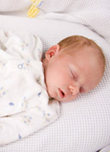Sleep patterns and routines
Did you know?
Newborn babies can take 6 to 10 weeks or even longer to develop a regular sleep pattern.
Sleep routines
When preparing babies and toddlers for sleep, it can be helpful to follow a routine that lets them know it is nearly time to go to sleep.
Below are some of the things Tina does to prepare Jessica and Tyler for sleep.
- only uses the room for the children to sleep in and both children are made aware of this (where possible the children sleep in the same place each day)
- tries to make the room relaxing and inviting, so the children feel comfortable and able to go to sleep easily
- keeps the room well ventilated and at a comfortable temperature
- changes the children's clothing to get them ready for bed. This lets them know it is time for sleep
- gives the children quiet time before sleep. Reads or tells them a story so they can relax and feel calm
- usually makes the room darker and plays soft, relaxing music
- realises both children are different in the way they like to go to sleep.
Click on each of the children to find out what their individual sleep routines are.
Jessica

When Jessica first started attending day care at two months of age, she was rocked to sleep while breastfeeding. This is what she was used to at home and what she and her mother enjoyed.
At about 3 months old, Jessica's mother could no longer pop in to feed Jessica, so she now expresses milk into a bottle. Jessica was introduced to the bottle, but she still needs to be held and cuddled whilst being fed. This provides opportunity for special bonding with the primary caregiver and is the safest way for a baby to be fed. Once she's finished feeding, she just lies in her cot until she dozes off.
Tyler

Tyler likes you to stay with him until he is asleep. He always has done. The different sleep routines enable me to build a really close relationship with both babies.
I hold Jessica while she feeds, and sit with Tyler while he falls asleep. Tyler likes to be patted but not all children do.
He goes into his cot with “Ruggy” (a small comforter blanket) and I pat him until he falls asleep.
Sleep patterns
Babies' sleep patterns will vary depending on their age, habits and personalities. Jessica and Tyler usually nap after lunch. Jessica, like a lot of babies her age, sleeps quite a lot of the day.
You have a new baby starting at the centre. You want to do all you can to cater for the baby’s needs. What information would you need to find out from the parents about the baby’s sleep patterns and routines at home to ensure that you can keep it similar at the centre?
In your notebook write down:
- the questions you would ask the parents
- the steps you would take to set up the baby’s sleep routine.
Sleep states
There are two major states of sleep. These are called rapid eye movement sleep (REM), known as active sleep (this is when dreaming takes place) and non-REM (or quiet) sleep.
During REM sleep there is slight movement under the eyelids and some body movement. During Non REM sleep we are in a very deep sleep, the body is very still and breathing is regular.
When we are sleeping we move through 4 stages from being awake through to REM sleep and then non REM sleep. This occurs in cycles through the night.
Infants have a greater amount of REM sleep than adults. The cycles of moving from REM sleep into non REM sleep are shorter in infants. A baby can be settled through the initial stage of REM sleep until they fall into deep quiet sleep. Also if a baby wakes during a period of REM sleep they may be more easily settled back to sleep.
What you observe when watching a baby sleep can help you identify which level of sleep they are in.
If you know someone who has a baby or you can visit a local child care service, spend some time watching a baby sleep. What do you notice? Do you see them making little noises, wriggling, tossing and turning or blinking their eyes rapidly? Write your observations in your notebook.
Sudden Infant Death Syndrome (SIDS) is a very important issue to be aware of and to actively try to prevent.
The SIDS Australia organisation does a lot of research into why some babies and infants mysteriously die in their sleep. They have developed some recommendations for preventing SIDS and how to correctly make up a baby's bed to reduce the risks.
Visit the SIDS Australia website to find out more information on how to reduce the risk: www.sidsandkids.org
In your notebook, write a list of the important factors to consider to reduce the risk of SIDs when putting an infant in a cot. Then draw a sketch of how an infant should be positioned in the cot.




